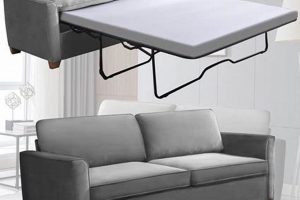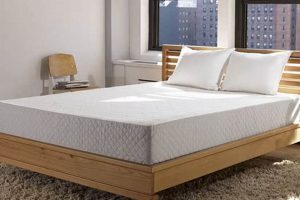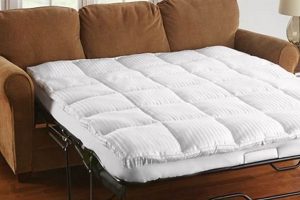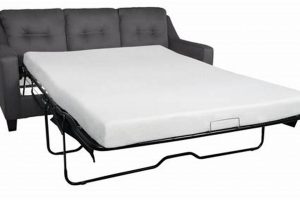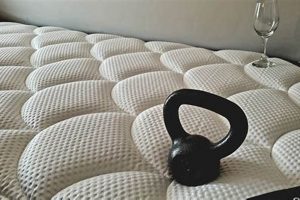The development of indentations or depressions in a sleep surface is a common issue that affects many mattresses. These areas, often corresponding to where an individual frequently rests, signify a loss of support and uniformity across the mattress surface. The consequence of this degradation is often a compromised sleep experience.
This phenomenon directly impacts sleep quality and musculoskeletal health. A mattress that no longer provides consistent support can lead to discomfort, disrupted sleep cycles, and potential exacerbation of back pain. Historically, mattress materials and construction techniques have played a significant role in determining the longevity and resistance to indentation. Modern materials and manufacturing processes aim to mitigate this problem, but material fatigue remains a key consideration.
Therefore, understanding the factors that contribute to mattress indentation, exploring preventative measures, and evaluating potential solutions are crucial steps in maintaining a comfortable and supportive sleep environment. This exploration will encompass mattress materials, construction methods, and proactive maintenance strategies designed to prolong the life and performance of a sleep surface.
Addressing Mattress Indentation Issues
The following guidelines offer practical approaches to mitigate the development and impact of surface depressions in mattresses, thereby extending the lifespan and comfort of the sleep surface.
Tip 1: Rotate the Mattress Regularly: Consistent rotation, ideally every three to six months, distributes wear more evenly across the surface. This practice helps prevent concentrated stress in specific areas, reducing the likelihood of localized indentation.
Tip 2: Flip the Mattress (If Applicable): Mattresses designed to be flipped should be turned over on the same rotation schedule. This utilizes both sides of the mattress, further distributing wear and tear and maximizing its usable life.
Tip 3: Utilize a Mattress Topper: A high-quality mattress topper can provide an additional layer of support and cushioning. This can minimize the direct pressure on the underlying mattress, delaying the onset of indentation.
Tip 4: Evaluate the Foundation: Ensure the mattress is resting on a solid and supportive foundation. A weak or damaged foundation can contribute to uneven weight distribution, accelerating the formation of dips.
Tip 5: Consider Body Weight Distribution: Individuals with significant weight may consider a mattress designed for heavier users. These mattresses typically feature reinforced support systems and denser materials, offering increased resistance to indentation.
Tip 6: Address Point Pressure: Avoid consistently placing heavy objects on the mattress. Concentrated pressure can contribute to localized depressions. Distribute weight evenly whenever possible.
Tip 7: Research Mattress Materials and Construction: Prior to purchasing a new mattress, research the durability and indentation resistance of various materials and construction methods. Certain materials, like high-density foam or innerspring systems with reinforced edges, tend to be more resistant to sagging.
Implementing these strategies can significantly enhance the longevity and performance of a mattress, ultimately promoting a more restful and supportive sleep experience.
Moving forward, the subsequent sections will delve into the materials commonly used in mattress construction and their relative susceptibility to indentation.
1. Material Fatigue
Material fatigue constitutes a primary causative factor in the formation of indentations within a mattress. This phenomenon describes the progressive and permanent degradation of mattress components due to repeated stress from compression and decompression cycles during sleep. Over time, the materials, particularly foams and fibers, lose their original resilience and structural integrity, resulting in localized depressions conforming to the sleeper’s body contours. The severity of these indentations is directly proportional to the intensity and duration of the applied pressure, as well as the inherent quality and composition of the mattress materials. For example, a memory foam mattress subjected to nightly use by a heavier individual will exhibit more pronounced and accelerated material fatigue compared to a latex mattress used by a lighter individual.
The role of material fatigue is critical in understanding mattress performance and longevity. It influences not only the physical appearance of the sleep surface but also the level of support provided. The progressive loss of support can lead to misaligned spinal posture, discomfort, and disrupted sleep. Furthermore, differential fatigue rates among various mattress layers can exacerbate the development of uneven surfaces. Consider a hybrid mattress with a lower-density foam comfort layer atop a more resilient innerspring core. The foam layer may exhibit significant fatigue and indentation while the innerspring core remains relatively unaffected, leading to an imbalanced and ultimately less supportive sleep experience.
In summary, material fatigue is an inevitable process in all mattresses, albeit at varying rates depending on material properties, usage patterns, and weight distribution. A thorough understanding of this process is essential for both consumers selecting a new mattress and manufacturers striving to improve product durability and longevity. Mitigating material fatigue through material selection and optimized construction techniques can significantly enhance the performance and lifespan of mattresses, thus contributing to improved sleep quality and user satisfaction.
2. Foundation Integrity
The structural integrity of a mattress foundation is inextricably linked to the overall support and longevity of the mattress itself. A compromised foundation can significantly contribute to the premature development of surface indentations and uneven wear patterns, ultimately impacting the quality of sleep.
- Impact on Weight Distribution
A weakened or uneven foundation fails to distribute weight uniformly across the mattress. This localized stress can lead to accelerated compression and degradation of mattress materials in specific areas, directly causing depressions where the sleeper frequently rests. Slatted foundations with broken or widely spaced slats are a common example of this issue.
- Influence on Mattress Conformity
An inadequate foundation may not provide the necessary support for the mattress to maintain its intended shape and conformity. This can result in the mattress sagging or dipping, especially in the center or along the edges, where support is often most critical. Innerspring mattresses are particularly susceptible to this, as their support system relies on a solid, even base.
- Contribution to Material Stress
A foundation that lacks rigidity or stability can introduce excessive stress on the mattress materials. This stress can manifest as bending or twisting of the mattress, leading to premature wear and tear of internal components, and ultimately, the formation of lasting indentations. The use of an old or damaged box spring with a new mattress exemplifies this scenario.
- Role in Mattress Ventilation
Some foundations are designed to promote airflow around the mattress, preventing moisture buildup and regulating temperature. A foundation that restricts airflow can lead to material breakdown and compression over time, increasing the likelihood of indentations. This is particularly relevant for memory foam mattresses, which can trap heat and moisture.
In summary, a robust and well-maintained foundation is essential for preserving the structural integrity and performance of a mattress. Neglecting the foundation can negate the benefits of even the highest-quality mattress, leading to discomfort, compromised sleep, and a reduced lifespan of the sleep system.
3. Weight Distribution
Weight distribution is a key factor in the premature development of indentations within a mattress. Concentrated pressure from an individual’s sleeping position or body weight can accelerate material fatigue, leading to localized depressions and a compromised sleep surface.
- Concentrated Pressure Points
Specific areas of the body, such as the hips and shoulders, often exert greater pressure on the mattress. Over time, this concentrated force can compress the underlying materials, leading to permanent indentations. The extent of indentation is directly related to the individual’s weight and preferred sleeping position. For example, side sleepers may experience more pronounced dips under their hips and shoulders due to the increased pressure in those areas.
- Uneven Support Systems
Mattresses with inadequate or uneven support systems are more susceptible to indentation under concentrated weight. If the internal structure of the mattress is unable to distribute weight effectively, pressure will be localized, leading to faster material degradation. This is particularly relevant for older mattresses with worn-out springs or low-density foam, which offer minimal resistance to compression.
- Surface Area Considerations
The surface area over which weight is distributed significantly impacts the degree of indentation. A larger individual will exert more pressure per square inch compared to a smaller individual, resulting in a higher risk of developing mattress depressions. Similarly, a shared sleeping surface with two individuals will experience greater overall weight distribution, potentially accelerating wear and tear, especially if weight distribution is uneven.
- Mattress Material Properties
The inherent properties of mattress materials influence their ability to withstand concentrated weight. High-density foams, latex, and innerspring systems with reinforced edges are generally more resistant to indentation compared to low-density foams or fiberfill. The selection of appropriate materials is therefore critical in mitigating the effects of weight distribution on mattress longevity and performance.
The interplay between weight distribution, support systems, and material properties determines the rate at which a mattress develops indentations. By understanding these factors, individuals can take proactive steps to prolong the life of their mattress and maintain a comfortable and supportive sleep surface. Strategies such as rotating the mattress, using a supportive foundation, and choosing a mattress designed for their body weight and sleeping preferences can significantly reduce the risk of premature indentation and ensure a restful sleep experience.
4. Construction Quality
The manufacturing quality of a mattress is a critical determinant of its long-term resilience and resistance to the development of surface indentations. Substandard construction practices can compromise the structural integrity of the mattress, accelerating material fatigue and leading to localized depressions in areas of frequent use.
- Core Support System Integrity
The core support system, typically consisting of innersprings, coils, or a dense foam core, provides the primary foundation for weight distribution and pressure relief. Inadequate coil gauge, insufficient coil density, or the use of low-quality foam can result in uneven support, leading to sagging and indentations. For example, a mattress with loosely connected coils is more likely to develop dips compared to one with individually pocketed coils.
- Edge Support Reinforcement
Reinforced edge support is essential for maintaining the structural integrity of the mattress perimeter. Weak edge support allows the edges to compress and collapse over time, creating a bowl-like shape and reducing the usable sleep surface. Mattresses lacking adequate edge reinforcement are particularly prone to sagging along the sides, especially for individuals who sleep near the edge of the bed.
- Upholstery Layer Composition and Density
The composition and density of the upholstery layers, including comfort foams, fibers, and quilting, significantly impact the mattress’s ability to resist indentation. Low-density foams and loosely packed fibers compress more readily under pressure, resulting in faster material fatigue and the formation of surface depressions. A mattress constructed with high-density memory foam or latex is generally more resistant to indentation than one with conventional polyurethane foam.
- Seam Strength and Stitching Quality
The strength and durability of the seams and stitching contribute to the overall structural integrity of the mattress. Weak seams or poorly executed stitching can lead to shifting and bunching of the upholstery layers, creating uneven surfaces and localized depressions. A mattress with reinforced seams and durable stitching is less likely to develop dips due to material displacement.
In conclusion, meticulous attention to construction quality is paramount in mitigating the development of mattress indentations. A mattress constructed with a robust core support system, reinforced edge support, high-density upholstery layers, and durable seams is more likely to maintain its shape and provide consistent support over its lifespan. Conversely, mattresses with substandard construction are inherently more susceptible to sagging and indentation, ultimately compromising sleep quality and long-term durability.
5. Usage Patterns
Usage patterns significantly influence the structural integrity and longevity of a mattress. The manner in which a mattress is used directly affects the rate at which indentations develop, impacting sleep quality and overall product lifespan. Consistent and predictable usage patterns can lead to localized wear and tear, ultimately contributing to surface depressions.
- Sleeping Position Preferences
Dominant sleeping positions, such as side sleeping or stomach sleeping, concentrate pressure on specific areas of the mattress. Over time, these consistent pressure points can cause the underlying materials to compress and deform, leading to noticeable dips. For instance, a dedicated side sleeper may observe deeper indentations under their hips and shoulders compared to other areas of the mattress.
- Single vs. Double Occupancy
A mattress used by a single individual experiences a different weight distribution compared to one shared by two people. Double occupancy increases the overall weight and pressure on the mattress, potentially accelerating material fatigue and the formation of indentations, particularly if there are significant differences in weight between the occupants. Uneven weight distribution can result in asymmetrical dips across the mattress surface.
- Frequency of Use
The frequency with which a mattress is used contributes to its overall wear and tear. A mattress used nightly will experience greater stress and compression compared to one used only occasionally, such as in a guest bedroom. Continuous use without proper maintenance, such as regular rotation, can exacerbate the development of indentations in high-pressure areas.
- Activities Conducted on the Mattress
Activities beyond sleep, such as sitting upright to read or work on a laptop, can create localized pressure points and contribute to mattress indentations. These activities often concentrate weight in a smaller area, leading to accelerated compression of the underlying materials. Consistent sitting in the same spot can create a noticeable dip over time.
The aforementioned usage patterns highlight the direct correlation between how a mattress is used and its susceptibility to indentation. Understanding these patterns allows for proactive measures, such as rotating the mattress regularly, to mitigate the effects of concentrated pressure and prolong the lifespan of the sleep surface. Moreover, considering these factors when selecting a mattress can help individuals choose a product better suited to their specific needs and usage habits, ultimately contributing to a more comfortable and supportive sleep experience.
Frequently Asked Questions
The following questions address common concerns and misconceptions regarding mattress indentations and their impact on sleep quality. Understanding these issues is crucial for maintaining a comfortable and supportive sleep environment.
Question 1: What constitutes a normal amount of indentation in a mattress?
A slight body impression is generally considered normal, particularly in mattresses with conforming materials like memory foam. However, indentations exceeding a certain depth (typically around 1.5 inches) may indicate a structural issue.
Question 2: What are the primary factors contributing to mattress indentations?
The primary factors include material fatigue, uneven weight distribution, inadequate foundation support, and the quality of mattress construction. Usage patterns and sleeping positions also play a significant role.
Question 3: Can mattress indentations be repaired?
Minor indentations may improve with mattress rotation or the addition of a mattress topper. However, significant indentations typically indicate irreversible damage requiring mattress replacement. Professional mattress repair services may offer limited solutions in certain cases.
Question 4: How can mattress indentations be prevented?
Preventative measures include rotating or flipping the mattress regularly (if applicable), using a supportive foundation, distributing weight evenly, and selecting a mattress constructed with durable materials.
Question 5: Does a mattress warranty cover indentations?
Most mattress warranties cover indentations exceeding a specified depth (often around 1.5 inches), provided they are not caused by misuse or abuse. It is essential to review the warranty terms and conditions for specific coverage details.
Question 6: How does mattress material affect indentation resistance?
Mattresses constructed with high-density foams, latex, or innerspring systems with reinforced edges are generally more resistant to indentation compared to those with low-density foams or fiberfill. Material selection is a crucial factor in determining mattress longevity.
Understanding the causes, prevention, and potential remedies for mattress indentations empowers individuals to make informed decisions regarding mattress maintenance and replacement.
The subsequent section will address specific mattress types and their relative susceptibility to indentation.
Addressing Sleep Surface Degradation
This examination of the issue of sleep surface indentation has highlighted the multifaceted nature of the problem. From material fatigue and foundation integrity to weight distribution and construction quality, a variety of factors contribute to the phenomenon where a mattress has dips where i sleep. Understanding these contributing elements is essential for both consumers and manufacturers seeking to mitigate the premature degradation of sleep surfaces.
The long-term implications of a degraded sleep surface extend beyond mere discomfort. The compromised support and uneven weight distribution associated with mattress indentations can negatively impact spinal alignment and overall sleep quality. Therefore, addressing this issue through informed purchasing decisions, proactive maintenance practices, and ongoing research into more durable materials and construction techniques remains a critical endeavor for ensuring restful and restorative sleep.


